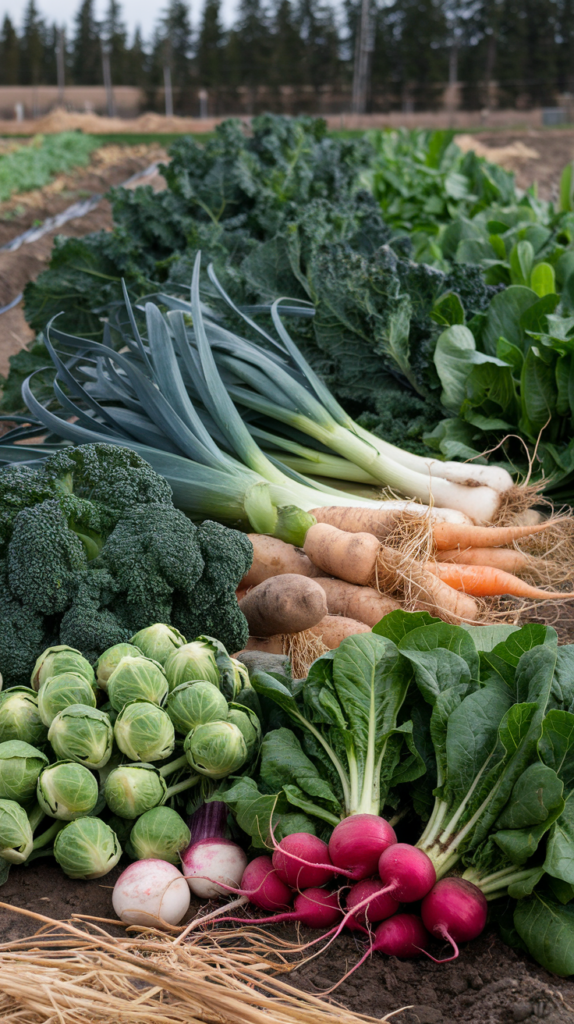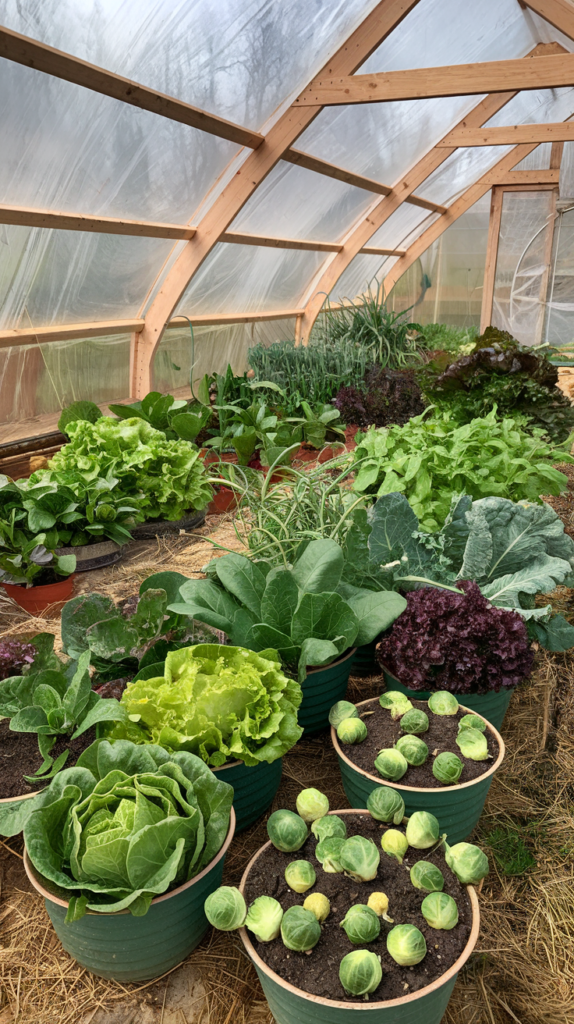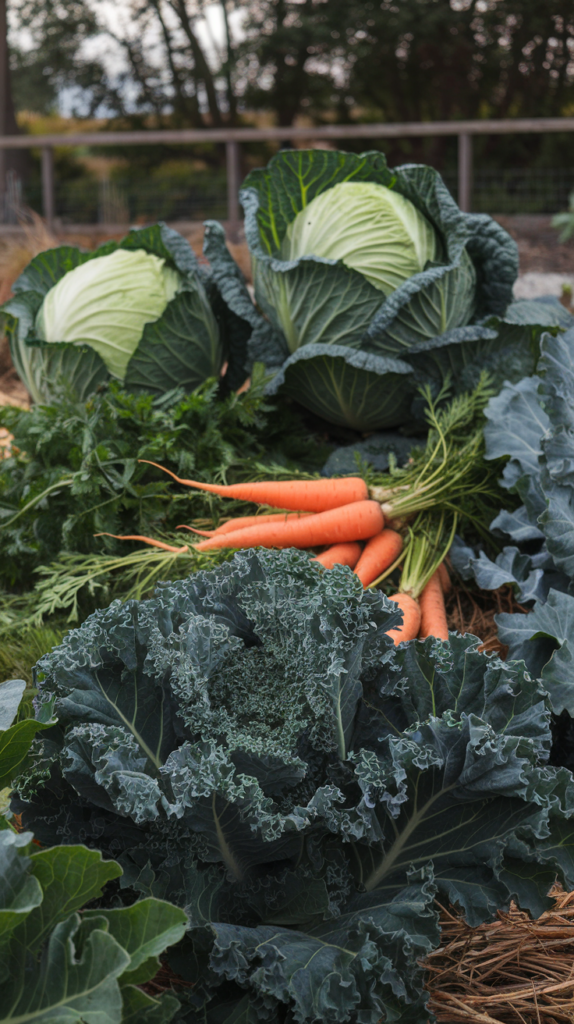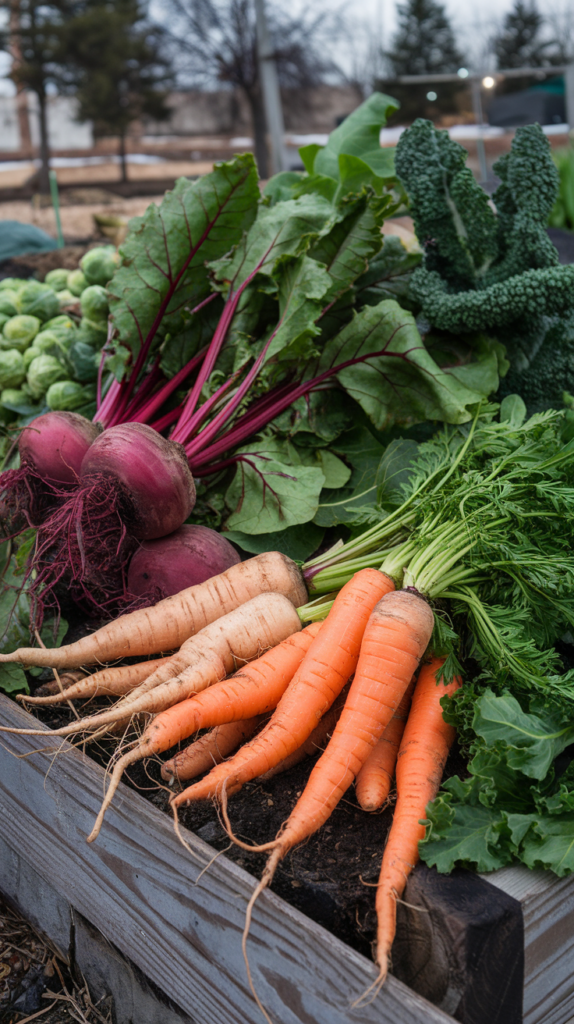11 Winter Vegetables to Grow in Cold Climates
Growing winter vegetables can be a rewarding endeavor, particularly in cold climates where options may seem limited. With the right choices and techniques, you can harvest fresh produce even when the temperature drops. Below, we’ll explore 11 winter vegetables that thrive in chillier weather, along with tips for growing them in various environments, such as pots, greenhouses, and indoors.
1. Kale
Kale is one of the hardiest winter vegetables. It can survive temperatures as low as 20°F (-6°C) and often becomes sweeter after frost. This leafy green is packed with vitamins A, C, and K, making it an excellent choice for winter harvesting.
Growing Tips:
- Location: Plant in well-drained soil with full sun to partial shade.
- Spacing: Space plants 12 to 18 inches apart.
- Harvest: Pick the outer leaves first, allowing the inner leaves to continue growing.
2. Spinach
Spinach is another excellent choice for winter growing vegetables. It thrives in cool weather, and like kale, it can handle frost, which actually improves its flavor.
Growing Tips:
- Planting: Sow seeds in late summer or early fall for a winter harvest.
- Soil: Ensure soil is rich in organic matter.
- Watering: Keep the soil consistently moist but not waterlogged.
3. Carrots
Carrots are root vegetables that can be sown in the late summer or fall and harvested throughout winter. They can tolerate cold and actually improve in flavor after exposure to frost.
Growing Tips:
- Soil: Use loose, sandy soil to facilitate growth.
- Depth: Plant seeds ¼ inch deep and thin seedlings to 2 inches apart.
- Harvest: Use mulch to protect them from extreme cold.
4. Beets
Beets are versatile and nutritious, offering both greens and roots for harvest. They are resilient in cold weather, making them ideal for winter vegetable gardens.
Growing Tips:
- Planting: Directly sow seeds in well-drained soil.
- Spacing: Space seeds 2 to 4 inches apart in rows.
- Harvest: Harvest greens while roots can remain in the ground for later use.
5. Swiss Chard
Swiss chard is not only colorful but also highly nutritious. It can tolerate frost and grows well in various soil types, making it one of the best vegetables to grow in winter.
Growing Tips:
- Sunlight: Requires full sun but can tolerate partial shade.
- Spacing: Space plants 12 inches apart.
- Harvest: Cut outer leaves to encourage new growth from the center.
6. Winter Radishes
Winter radishes, such as daikon and black radishes, are perfect for winter gardens. They mature quickly and can be harvested throughout the cold months.
Growing Tips:
- Soil: Requires fertile, well-drained soil.
- Spacing: Plant seeds ½ inch deep and 2 to 3 inches apart.
- Harvest: They can remain in the ground until you’re ready to eat them.
7. Garlic
While garlic is technically planted in the fall, it is harvested in late spring or early summer. Planting garlic in winter allows for an earlier harvest and gives it time to establish roots before the frost.
Growing Tips:
- Location: Choose a sunny spot with well-drained soil.
- Spacing: Plant cloves 2 inches deep and 6 inches apart.
- Mulching: Apply mulch to protect from extreme cold.
8. Onions
Onions can be grown as winter vegetables to grow in pots or in the ground. They can be planted as sets or seeds in late summer for an early spring harvest.
Growing Tips:
- Soil: Requires fertile, well-drained soil.
- Spacing: Space sets 4 inches apart.
- Protection: Use row covers to shield young plants from frost.
9. Brussels Sprouts
Brussels sprouts thrive in cool weather, making them ideal for winter gardening. They develop a better flavor after a frost, enhancing their sweetness.
Growing Tips:
- Planting: Start seeds indoors and transplant them or sow seeds directly outdoors in late summer.
- Spacing: Space plants 24 inches apart.
- Harvest: Pick the sprouts from the bottom up as they mature.
10. Leeks
Leeks are a fantastic choice for those looking to grow vegetables in winter. They have a long growing season and can withstand frost.
Growing Tips:
- Soil: Needs rich, moist soil.
- Spacing: Space them 6 inches apart.
- Harvest: Use mulch for protection and allow leeks to grow until they reach the desired size.
11. Peas
Peas can be grown in early spring or late fall and often survive winter in milder climates. They are a nitrogen-fixing crop, benefiting your soil.
Growing Tips:
- Planting: Sow seeds in late summer for fall harvest or early spring for winter.
- Support: Provide trellis or support for climbing varieties.
- Harvest: Pick pods when they are plump but still tender.
Growing Techniques for Winter Vegetables
Growing Vegetables in Pots
For those with limited space, growing winter vegetables in pots can be an excellent solution. Select containers that allow for good drainage and use high-quality potting soil. Many of the vegetables listed above, such as kale, spinach, and herbs, can thrive in pots, making them perfect for small gardens or patios.
| Vegetable | Ideal Pot Size | Sun Requirements |
|---|---|---|
| Kale | 12-16 inches | Full sun |
| Spinach | 10-12 inches | Partial shade |
| Carrots | 12-18 inches | Full sun |
| Swiss Chard | 10-12 inches | Full sun |
Growing Vegetables Indoors During Winter
If the weather is too harsh, consider growing vegetables indoors during winter. This can include using grow lights or placing pots near sunny windows. Vegetables like lettuce, radishes, and herbs can flourish indoors.
| Vegetable | Light Requirement | Recommended Container |
|---|---|---|
| Lettuce | 12-16 hours | 8-10 inches deep |
| Radishes | 10-12 hours | 6-8 inches deep |
| Herbs (Basil, Thyme) | 10-12 hours | 6-8 inches deep |
Greenhouse Gardening
For those with access to a greenhouse, winter gardening becomes even more productive. A greenhouse creates a controlled environment that can protect plants from extreme temperatures while allowing you to extend the growing season significantly.
Vegetables to Grow in a Greenhouse in Winter
In a greenhouse, you can grow a wider variety of vegetables, including:
- Tomatoes (start early in the season)
- Peppers (provide warmth)
- Cucumbers (great for early spring)
| Vegetable | Best Planting Time | Temperature Needs |
|---|---|---|
| Tomatoes | Early Spring | 70°F+ |
| Peppers | Late Spring | 70°F+ |
| Cucumbers | Early Summer | 60°F+ |
Embracing Winter Gardening
Growing vegetables during winter opens a world of possibilities for fresh produce even in cold climates. With careful planning and the right choices, you can enjoy a bounty of easy winter vegetables to grow. From kale to beets, these vegetables not only provide nourishment but also help combat the winter blues. Whether you choose to cultivate them in pots, indoors, or a greenhouse, the key is to select resilient varieties that can thrive in cold weather. Happy gardening!




